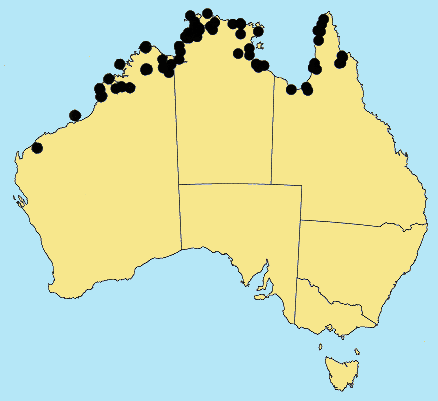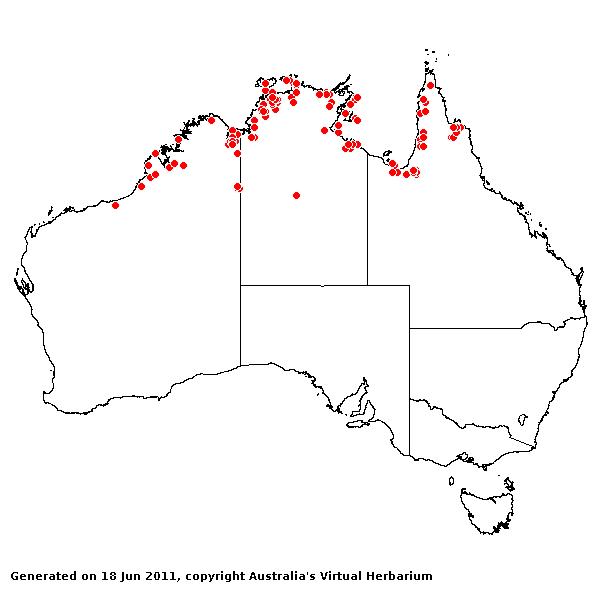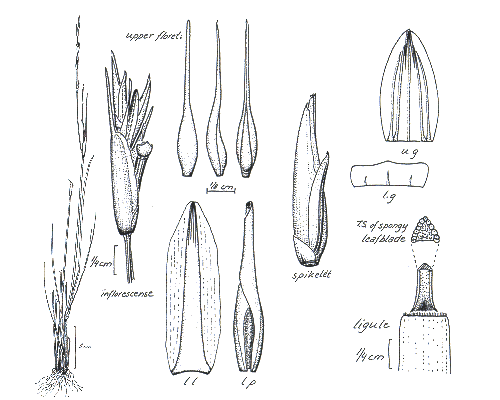Xerochloa imberbis R.Br. Prodr. 197
(1810).
Classification. (GPWG 2001) : Subfamily
Panicoideae. Paniceae.
Common name:
Northern Rice Grass, Rice Grass.
Type of Basionym or
Protologue Information: Australia:
R. Brown 6143 (K iso).
Key references
(books and floras): [1810]. R.Brown, Prodromus (197), [1878]
G.Bentham, Flora Australiensis 7 (501), [1952] C.A.Gardner, Flora of Western Australia 1 Gramineae (294), [2002]
D.Sharp & B.K.Simon, AusGrass, Grasses of Australia.
Illustrations:
[1952] C.A.Gardner, Flora of Western
Australia 1 Gramineae (292, Pl.86).
Derivation:
Latin for beardless. Glumes and/or lemmas glabrous.
Habit.
Perennial. Rhizomes present, short. Culms geniculately ascending or decumbent,
15–75 cm tall, 3–5 -noded. Mid-culm internodes solid or spongy. Mid-culm nodes
glabrous. Ligule a fringe of hairs, 0.15–0.5 mm long. Leaf-blades linear or
filiform, flat or involute, 6–25 cm long, 0.8–4 mm wide.
Inflorescence.
Inflorescence compound, a panicle of spikes.
Spikelets.
Spikelets sessile. Fertile spikelets 2-flowered, the lower floret barren
(rarely male), the upper fertile, comprising 1 basal sterile florets,
comprising 1 fertile floret(s), without rachilla extension, lanceolate,
dorsally compressed, 5.8–12 mm long.
Glumes. Glumes
dissimilar, thinner than fertile lemma. Lower glume oblong or ovate, hyaline or
membranous, without keels, 0 -nerved. Upper glume lanceolate or oblong, 4.5–9
mm long, chartaceous, without keels, 5 -nerved. Upper glume surface glabrous. Florets.
Basal sterile florets 1, male, with palea. Lemma of lower sterile floret 100 %
of length of spikelet, chartaceous, 5–7 -nerved. Fertile florets female.
Fertile lemma 5.5–11
mm long, without keel. Anthers 3.
Continental
Distribution: Tropical Asia and Australasia.
Australian
Distribution: Western Australia, Northern Territory, Queensland.
Western Australia: Gardner, Dampier. Northern Territory: Darwin & Gulf, Victoria
River. Queensland:
Burke, Cook.
Notes.
The leaf blades have a thickened and spongy adaxial mesophyll and epidermis.
Diagnostic features include spikelet shape and the glabrous rachis.
Occurs in coastal
saline areas from W.A. to tropical Qld. In tropical and subtropical sub-humid
woodlands and coastal grasslands. Flowers mostly Feb.-Sept.



